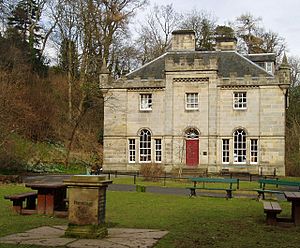Hermitage of Braid facts for kids
The Hermitage of Braid is a beautiful natural area in Edinburgh, Scotland. It sits between two hills, the Braid Hills and Blackford Hill. A small river called the Braid Burn flows right through it. This special place is part of a bigger area known as the Hermitage of Braid and Blackford Hill Local Nature Reserve. It covers about 60 hectares, which is like 150 football fields!
History of the Hermitage
The Old Estate
For a long time, the land known as Braid belonged to a family called de Brad. One member of this family, Henri de Brad, was a very important official in Edinburgh in the 1100s. He was called the Sheriff of Edinburgh. A sheriff back then was like a local leader who made sure laws were followed. There was even a castle on this land for many years. It stood there until the 1700s.
A New House
In the 1700s, a lawyer named Charles Gordon bought the Braid estate. He decided to build a new house there. This house, built in 1785, is now known as Hermitage House. It stands on the north side of the Braid Burn river. The house was designed by an architect named Robert Burn. It looks a bit like a castle with its special "castellated Gothic" style. This style might have been inspired by another famous architect, Robert Adam. Charles Gordon's son, Colonel John Gordon, was a soldier and a Member of Parliament (MP). An MP is a person elected to make laws for the country. Today, Hermitage House is a very important building. It is a "Category A listed building," which means it's protected because of its special history and architecture.
A Public Park
In 1937, the owner of the Hermitage, John McDougal, did something wonderful. He gave the land to the city of Edinburgh. He wanted it to be a public park for everyone to enjoy. A special stone pillar in the park tells the story of this gift. It also records that the park officially opened on June 10, 1938. The Lord Provost of Edinburgh, Sir Louis Gumley, opened it. A Lord Provost is like the mayor of a city in Scotland. Today, Hermitage House is a visitor centre for the nature reserve. It also holds offices for the City of Edinburgh Council's Countryside Natural Heritage Service.


